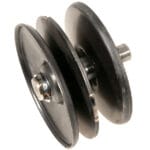Have you ever been halfway through mowing your lawn when your MTD lawnmower suddenly loses its edge? It might be time to check the variable speed pulley.
This small but crucial component ensures your mower runs smoothly, letting you tackle your yard with ease. When it malfunctions, your lawn care routine can quickly become a frustrating experience. But don’t worry; repairing a variable speed pulley doesn’t have to be an intimidating task.
You’ll learn straightforward steps to fix the pulley yourself, saving you time and money. With clear instructions and useful tips, you’ll have your mower back in action in no time. Dive in to discover how you can keep your lawn looking pristine without the hassle.
Tools And Materials
Repairing a variable speed pulley on an MTD lawnmower requires the right tools and materials. Having everything prepared ensures a smooth and efficient repair process. Gather the necessary tools and materials before you begin the repair. This preparation helps avoid interruptions and ensures all components are at hand.
Tools You Will Need
- Socket Set:A socket set is crucial for removing bolts.
- Wrench:Use an adjustable wrench for various bolt sizes.
- Screwdriver:A flathead and Phillips screwdriver are needed.
- Allen Wrench Set:Essential for handling hex screws.
- Torque Wrench:Ensures bolts are tightened to the correct specification.
- Rubber Mallet:Useful for loosening tight components without damage.
Materials Required For The Repair
- Replacement Pulley:Ensure it’s compatible with your MTD model.
- Belt:A new belt might be necessary for optimal performance.
- Lubricant:Use a suitable lubricant for moving parts.
- Cleaning Cloth:Keep the area clean and free of debris.
- Safety Gear:Wear gloves and safety glasses for protection.
- Disconnect the Spark Plug:Prevents accidental starting during repair.
- Work in a Well-lit Area:Ensures visibility and precision.
- Use a Stable Surface:A stable surface prevents the lawnmower from tipping.
Safety Precautions
Ensure safety by disconnecting the lawnmower’s spark plug before repairs. Wear gloves to protect your hands from sharp edges. Use appropriate tools to avoid damage or injury.
When you’re diving into the repair of a variable speed pulley on your MTD lawnmower, safety is your first stop. It’s not just about protecting yourself from harm; it’s about ensuring your repair process is smooth and stress-free. By focusing on safety precautions, you’ll be setting the foundation for a successful repair.1. Wear Appropriate Safety Gear
Always start with the basics. Equip yourself with safety goggles to protect your eyes from debris. Gloves can shield your hands from sharp parts and hot surfaces. It’s also wise to wear sturdy footwear to guard against dropped tools or parts.2. Disconnect The Spark Plug
Before you do anything else, disconnect the spark plug. This prevents accidental engine starts while you’re working. It’s a simple step, but it can save you from potential injuries.3. Use The Right Tools
Gather the necessary tools before beginning the repair. Using the wrong tool can lead to slips or damage to the pulley. Double-check that you have wrenches, screwdrivers, and pliers appropriate for your lawnmower model.4. Work In A Well-lit Area
Ensure your workspace is well-lit. Poor lighting can lead to mistakes or accidents. If you’re working in a dim garage, consider using a portable lamp or flashlight.5. Stabilize The Lawnmower
Make sure your lawnmower is on a stable, flat surface. You don’t want it tipping over while you’re working. Use blocks or chocks to secure the wheels if necessary.6. Keep Your Workspace Clean
A cluttered workspace is an accident waiting to happen. Clear away unnecessary tools and parts. This will not only prevent trips and falls but also make finding tools easier.7. Be Aware Of Hot Parts
If you’ve been running your lawnmower, allow it to cool down before starting the repair. Touching hot parts can lead to burns. Always check the temperature of the engine and other components before handling them.8. Follow The Manual
Refer to your lawnmower’s manual for specific instructions on handling the variable speed pulley. The manual often includes warnings and tips for safe repair. Ignoring these can lead to errors or injuries. Taking these precautions might seem time-consuming, but they’re essential for a safe repair experience. Have you ever skipped a safety step and regretted it later? Prioritizing safety ensures you won’t make that mistake again.Identify Pulley Issues
Troubleshoot common pulley issues on your MTD lawnmower for smoother operation. Inspect for wear or misalignment. Replace damaged parts to ensure efficient performance.
Repairing a variable speed pulley on your MTD lawnmower can feel daunting, especially if you’re not sure where the problem lies. Identifying pulley issues is the first step in getting your lawnmower back in tip-top shape. Let’s break down how you can pinpoint what’s going wrong with your machine.Common Symptoms
Does your lawnmower seem less efficient or produce strange noises? These are telltale signs of pulley trouble. You might notice the mower struggles to change speeds or vibrates excessively. Sometimes, the mower may stop altogether, leaving you stranded mid-lawn. Look for visible damage on the pulley, like cracks or unusual wear. Remember when I was mowing last summer? My mower suddenly lost speed and started rattling like a loose toy. A quick inspection revealed the pulley was the culprit.Causes Of Malfunction
Pulley problems often stem from wear and tear. Over time, the pulley can become misaligned or damaged due to constant use. Debris can lodge itself in the pulley system, causing jams and affecting performance. Regular maintenance can prevent these issues but ignoring them can lead to bigger headaches. Consider if you’ve been using the lawnmower on rough terrain. This can accelerate the pulley’s deterioration. Have you checked for any signs of rust or corrosion? These can drastically affect the pulley’s function. Taking the time to identify these issues can save you from costly repairs. What’s been your experience with troubleshooting lawnmower problems? Share your thoughts and see if these insights resonate with your situation!
Credit: fantast.rs
Disassemble The Lawnmower
Repairing a variable speed pulley on an MTD lawnmower starts with disassembly. This task requires patience and a keen eye for detail. It’s crucial to follow each step carefully to avoid damage.
Removing The Deck
First, ensure the lawnmower is on a flat surface. This ensures stability during disassembly. Disconnect the spark plug to prevent accidental starts. Locate the screws or pins securing the mower deck.
Use a wrench or screwdriver to remove them. Carefully lift the deck away from the frame. Ensure all cables and belts are free from the deck. Store the deck in a safe place.
Accessing The Pulley
With the deck removed, locate the variable speed pulley. It’s usually near the rear wheels. Check for any debris or grass clippings around the pulley. Clean the area for better access.
Remove any cover or guard protecting the pulley. Use the appropriate tools to loosen and remove the pulley. Keep track of all bolts and washers for reassembly. Inspect the pulley for wear or damage.
Now, you can proceed with repairs or replacements as needed.
Inspect And Diagnose
Inspect and diagnose the variable speed pulley on your MTD lawnmower to identify wear or misalignment. Check for loose belts and damaged components to ensure smooth operation. Regular maintenance prevents costly repairs and extends your mower’s lifespan.
When your MTD lawnmower’s variable speed pulley isn’t performing as it should, it can lead to uneven grass cuts and a frustrating lawn care experience. Before jumping to conclusions and ordering replacement parts, it’s crucial to inspect and diagnose the problem. This step helps you understand what’s wrong and how to fix it. Let’s dive into the process of examining your lawnmower’s variable speed pulley system to identify any issues.Checking For Wear And Tear
Begin by visually examining the pulley. Look for obvious signs of wear such as cracks, grooves, or unusual rust. A pulley with visible damage might be the root of your speed issues. Feel the surface of the pulley. If it’s smooth, it’s likely in good condition. However, if it feels rough or jagged, it might be worn out. Consider how long you’ve been using the lawnmower. If it’s been several seasons, the pulley might naturally be wearing down. Regular use can gradually erode even the sturdiest components.Identifying Broken Components
Next, check for any broken components around the pulley. Look at the belt that runs through the pulley. If it’s frayed or cracked, it might be slipping and causing speed inconsistencies. Listen for unusual noises while the lawnmower is running. Squeaks or grinding sounds often indicate something is broken or misaligned. Think back to any recent incidents. Did you run over a rock or hard object? Such events can lead to sudden damage, breaking parts that affect the pulley’s function. Remember, the goal is to pinpoint the exact problem. This saves you time and money by addressing the specific issue rather than replacing the entire system. What have you discovered during your inspection? Share your findings in the comments below and let’s troubleshoot together!Repair Or Replace The Pulley
Fixing a variable speed pulley on an MTD lawnmower involves inspecting the belt and pulley for wear. Clean and lubricate moving parts to ensure smooth operation. If damage is severe, consider replacing the pulley for better performance.
Repairing or replacing the pulley on your MTD lawnmower can seem like a daunting task. However, with a little guidance and some practical know-how, you can get your mower back in top shape. Whether you decide to repair the existing pulley or replace it entirely depends on the level of damage and wear. Let’s dive into the specifics.Repair Techniques
Before deciding to replace, consider repairing the pulley if the damage is minimal. Start by cleaning the pulley thoroughly to remove any dirt or debris. You might be surprised how much this simple step can improve performance. Inspect for any visible cracks or signs of wear. If they’re minor, using an epoxy or a metal filler can be an effective fix. This can extend the life of the pulley and save you money. Remember to tighten any loose screws or bolts. This might sound basic, but loose components can mimic more serious issues. A friend once thought his pulley was beyond repair, only to find that a few turns of a wrench solved the problem.When To Replace
Sometimes, replacement is the best option. If the pulley is severely cracked or damaged beyond the help of repairs, it’s time to get a new one. Continuing to use a damaged pulley can lead to further damage to your lawnmower. Consider how often you’ve had to repair the pulley. If it’s a recurring issue, investing in a new one might be more cost-effective in the long run. Think of it as a long-term investment in your lawnmower’s functionality. Replacement is also a good idea if you notice the mower’s performance declining significantly. A new pulley can restore the speed and efficiency of your mower, making yard work less of a chore. Have you ever noticed how a small change can make a big difference? By taking the time to assess and decide whether to repair or replace, you’re ensuring your MTD lawnmower stays in optimal working condition. What will you choose for your mower’s pulley?Reassembly Process
Begin by carefully aligning the pulley components. Ensure each piece is in its correct position before tightening screws. Double-check all connections for stability, ensuring smooth operation.
Reassembling your MTD lawnmower after repairing the variable speed pulley can feel like putting together a puzzle. But don’t worry; with the right steps, you’ll have your mower running smoothly again. The reassembly process is crucial to ensure everything fits perfectly and operates efficiently. So, let’s dive into the steps, ensuring your mower is up and running in no time.Reinstalling The Pulley
Start by placing the pulley back onto the shaft. Ensure it aligns properly; misalignment can cause operational issues. Use a wrench to secure the pulley tightly. A loose pulley can lead to uneven mowing or even damage to the mower. Double-check the belt’s position around the pulley. It should sit snugly without any twists, which can affect the mower’s speed.Securing The Deck
Lift the mower deck back into its original position. Remember how it was set before disassembly; this will guide you in positioning it correctly. Secure the deck with bolts, tightening them evenly to maintain balance. Loose bolts can make the deck unstable, affecting the mower’s performance. Finally, give the deck a gentle shake. It should feel solid and immovable. If it wobbles, you might need to retighten some bolts. Have you ever been in the middle of mowing and faced issues with your lawnmower? Reassembling it correctly might just be the key to avoiding future headaches. Taking the time to ensure everything is in its place can save you from unexpected breakdowns.
Credit: m.youtube.com
Testing The Repair
Testing the repair ensures the MTD lawnmower’s variable speed pulley functions smoothly. Check the alignment and tension for optimal performance. Adjustments might be needed for proper operation and extended lifespan.
Testing the repair of your MTD lawnmower’s variable speed pulley is crucial. This step ensures the machine runs smoothly after the fix. Proper testing identifies any remaining issues that need addressing. Let’s dive into the operational checks and how to address any issues that may arise.Operational Checks
Begin with a visual inspection of the pulley. Check for any loose parts or unusual wear. Start the lawnmower and let it idle for a few minutes. Listen for any unusual noises. These could indicate a problem. Next, engage the drive system. Observe how the lawnmower responds. The transitions between speed settings should be smooth. If there are jerks or delays, adjustments might be necessary. Test the lawnmower on a flat surface. Ensure it maintains consistent speed without effort.Addressing Remaining Issues
If issues persist, recheck your repair steps. Ensure all components are correctly aligned and secured. Look for signs of wear on belts and pulleys. Replacing worn parts can solve performance problems. Test the variable speed control again. It should move easily without resistance. If the control feels stuck, inspect the cable. It might need lubrication or replacement. Persisting noises could mean loose bolts. Tighten them to ensure stability. By following these steps, your MTD lawnmower should function effectively. Regular maintenance will extend its lifespan. Keep an eye on performance to catch issues early.Maintenance Tips
Repairing a variable speed pulley on an MTD lawnmower involves checking for wear and ensuring smooth operation. Examine the pulley for damage and clean any debris. Replace worn parts to maintain optimal performance.
Maintaining your MTD lawnmower’s variable speed pulley not only extends its lifespan but also ensures that your lawn gets that perfect cut every time. Regular maintenance can prevent unexpected breakdowns and save you from costly repairs. Let’s dive into some practical maintenance tips that you can easily integrate into your lawn care routine.Inspect The Pulley Regularly
Make it a habit to inspect the pulley every time you use your mower. Look for signs of wear, such as cracks or bent edges. If you notice any damage, address it immediately to avoid further complications. Regular checks help you spot problems early. A stitch in time saves nine, right?Clean The Pulley And Belt
Dirt and grass clippings can accumulate around the pulley and belt. Use a brush or compressed air to clean these areas. Keeping the pulley clean ensures smooth operation. You wouldn’t want your lawnmower working harder than it needs to. Clean it regularly for optimal performance.Lubricate Moving Parts
Keep the moving parts well-lubricated to reduce friction. Use a lubricant specifically designed for lawnmowers. Apply it gently to the pulley and belt. Have you ever tried moving a rusty bike chain? Frustrating, isn’t it? Lubrication prevents that kind of hassle.Check The Tension
The tension in the belt affects how well the pulley functions. Test the tension by applying gentle pressure. It should have some give but should feel firm. An overly tight or loose belt can cause problems. Adjust it as needed for smooth operation.Replace Worn-out Parts Promptly
Parts like the belt and pulley won’t last forever. When they start showing signs of significant wear, replace them. Keeping worn-out parts can lead to bigger issues. Think of it as changing a worn-out shoe; you wouldn’t keep wearing it and risk injury, would you?Store The Mower Properly
If you’re not using the mower for an extended period, store it in a dry place. Moisture can cause rust and damage over time. Proper storage prolongs the life of your mower. Treat it well, and it will serve you well. By following these maintenance tips, you not only save money but also ensure that your MTD lawnmower performs at its best. Remember, a well-maintained mower is a happy mower, and a happy mower means a beautifully kept lawn.
Credit: harubina.co.jp
Frequently Asked Questions
How Do I Identify A Faulty Variable Speed Pulley?
Listen for strange noises. Check for visible wear or damage. A faulty pulley can affect mower performance.
What Tools Are Needed For Pulley Repair?
Basic tools like screwdrivers, wrenches, and pliers are essential. A pulley puller might be needed too.
Can I Repair The Pulley Myself?
Yes, with basic mechanical skills. Follow the manual. Safety first. Take your time.
How Long Does Pulley Repair Take?
It usually takes about an hour. Time can vary based on experience and mower model.
How Often Should I Check The Pulley?
Check the pulley every season. Regular inspection prevents bigger problems. Ensure smooth operation and longevity.
Conclusion
Fixing the variable speed pulley on your MTD lawnmower is doable. Follow the steps with patience. Gather necessary tools before starting the repair. Safety is important. Wear gloves and protect your eyes. Inspect the pulley for wear or damage. Replace faulty parts promptly.
Check the alignment carefully. Ensure the belt is tight and secure. Test the lawnmower for smooth operation. Regular maintenance prevents future issues. Enjoy mowing with a well-functioning lawnmower. Share your repair experience with others. Encourage friends to repair instead of replacing.
Feel satisfied with your DIY skills.




